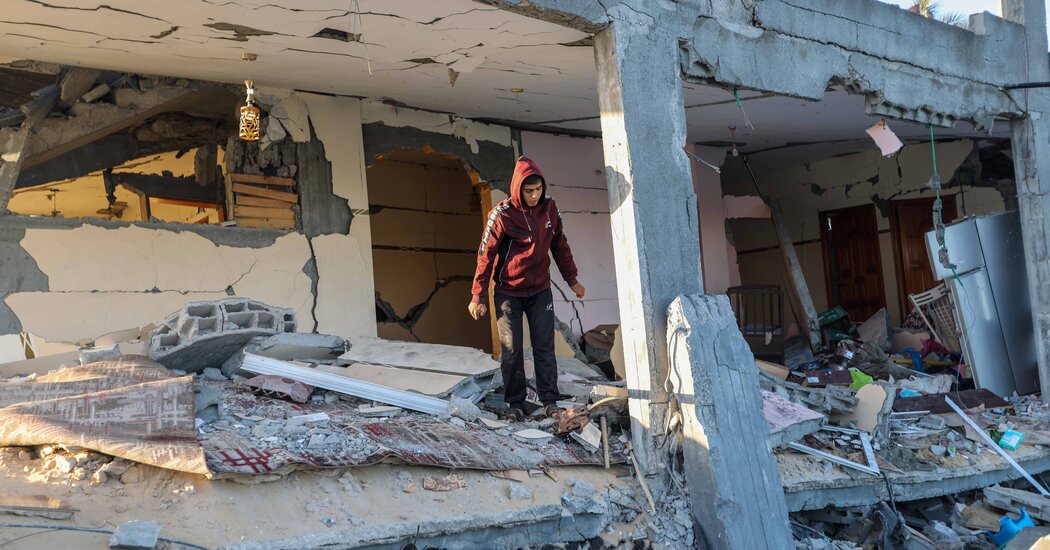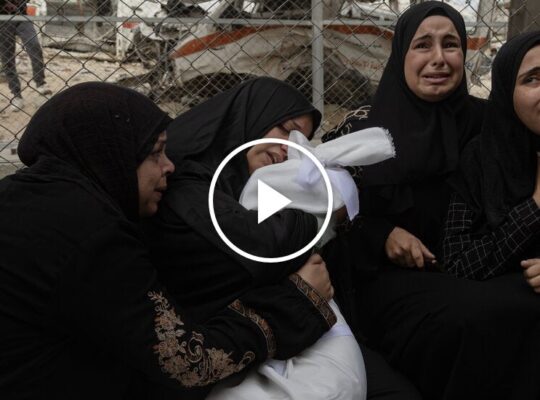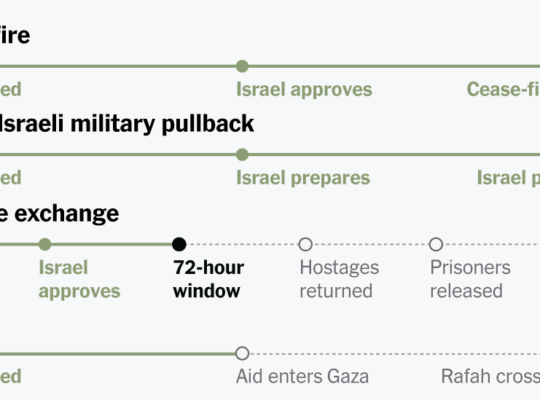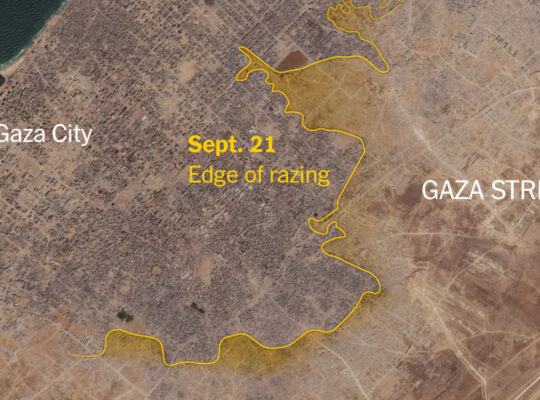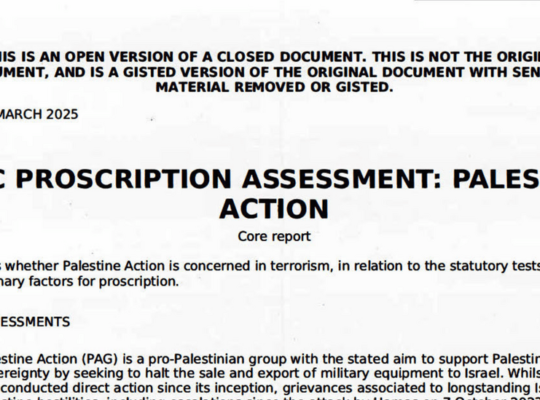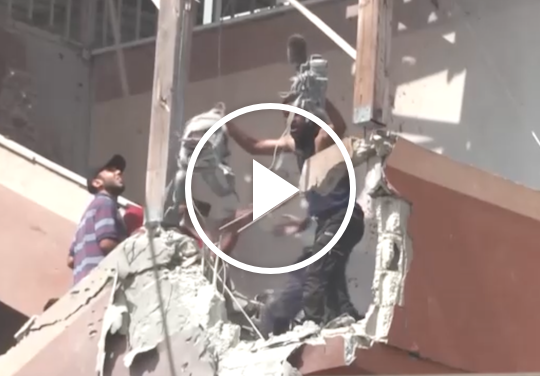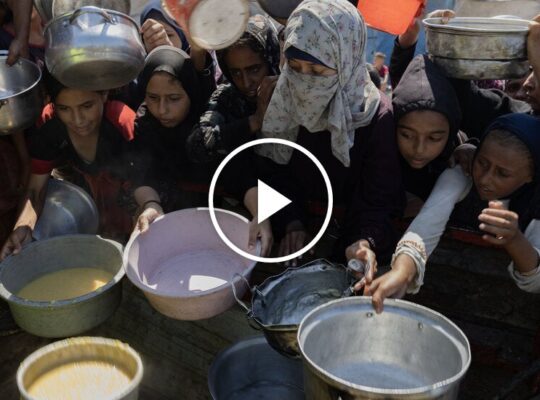For at least the second time in just over two weeks, a convoy bringing aid to hunger-stricken northern Gaza ended in bloodshed late Thursday when Palestinians were killed and wounded in an attack surrounding the trucks, according to Gazan health officials and the Israeli military, which offered divergent accounts of what happened.
The Gaza Health Ministry said that at least 20 people had been killed and more than 150 injured, and it accused Israeli forces of carrying out a “targeted” attack against “a gathering of civilians waiting for humanitarian aid” near the Kuwait traffic circle in Gaza City.
The Israeli military denied the allegation in a statement on Friday, blaming Palestinian gunmen and saying that an “intensive preliminary review” had determined “that no tank fire, airstrike or gunfire was carried out toward the Gazan civilians at the aid convoy.” It did not say whether Israeli forces had opened fire at all.
The descriptions of chaos and violence, and the conflicting accounts for what caused it, resembled those that emerged after bloodshed in late February, when more than 100 people were killed or injured amid Israeli fire around a convoy in Gaza City. The Israeli military has said that most of the people died in a stampede and that some were run over by the trucks. Israel, which has been under growing pressure to allow more aid into the territory, had organized that convoy to northern Gaza, where the United Nations has warned that hundreds of thousands of people are facing starvation.
It was not clear immediately on Friday who had sent the latest supplies, driven the trucks or provided security for them. The U.N. agency for Palestinian refugees, UNRWA, said it was not involved. The Israeli military said it had “facilitated the passage” of the 31 trucks but did not elaborate on that.
Three witnesses described shelling at the scene, and a doctor who treated victims at a hospital said their wounds appeared to be consistent with artillery shells, not bullets from rifles, suggesting the use of Israeli arms.
One of the witnesses, Mohammad Hamoudeh, a photographer in Gaza City, said that he did not see any Israeli forces or the weapons that fired on the crowd. But he said that heavy Israeli fire from a distance appeared to be responsible for the casualties.
“The cannons and tank shells are what targeted the civilians,” he said.
“I escaped by a miracle; we saw death with our eyes,” he said. Referring to the earlier convoy disaster, he said: “It was almost the same scenario as the Nabulsi incident. There were many martyrs. The scene was horrifying.”
Even after the bloodshed, people collected what aid they could, he said, including sacks of flour that had been bloodied.
Ali Al Ajouri, a 16-year-old from Jabaliya, also described shelling on the crowd. “There were some 30 people gathering in one spot, and a shell shot them directly,” he said.
Dr. Eid Sabbah, the head of nursing at the Kamal Adwan Hospital, said: “It wasn’t gunfire. It was ammunition from heavy weaponry that cause large openings; that’s obvious from the entrance and exit wounds.”
Dr. Sabbah said the patients who were treated at the hospital had mostly chest and head wounds. Doctors there could only stabilize them and keep them alive, he said, and were unable to perform surgery because of the lack of medicine and medical tools.
Ibrahim Al Najjar, 42, an unemployed taxi driver, said he was in the area around 8 p.m. when a large crowd had gathered. Soon, there was shelling and shooting, he said. He said that his cousin was killed and that he was injured in his right arm by shrapnel.
“I ran for my life with others, and then they hit a building next to us,” he said. “We kept running until we reached some ambulances far away.”
The Israeli military said it was not responsible for the attack. “Approximately one hour before the arrival of the convoy to the humanitarian corridor, armed Palestinians opened fire while Gazan civilians were awaiting the arrival of the aid convoy,” the military said. “As aid trucks were entering, the Palestinian gunmen continued to shoot as the crowd of Gazans began looting the trucks. Additionally, a number of Gazan civilians were run over by the trucks.”
The killing at the convoy came as Israel has been facing intense international pressure to allow more aid into Gaza, where aid workers have warned of calamitous hunger, spreading diseases and widespread lawlessness. People have become so desperate for food that some have resorted to eating leaves and animal feed. At least 27 people, including 23 children, have died of malnutrition, dehydration and lack of baby formula, according to the Gaza Health Ministry.
Aid groups have called on Israel to open more border crossings directly into northern Gaza, where food shortages are most extreme, and to ease restrictions on convoys.
Aid groups have said stopping the war is ultimately the only way to help ease the privation in Gaza. But Prime Minister Benjamin Netanyahu of Israel on Friday rejected the latest cease-fire and hostage-release deal proposed by Hamas, calling its demands “ludicrous,” and said Israel would move forward with plans for a ground offensive in the southern city of Rafah, where more than half the enclave’s population is sheltering.
The prospect of an invasion there has caused widespread alarm, including from the Biden administration, which has said it will oppose such an incursion without a credible plan to relocate civilians out of harm’s way.
As Israel has tightened a restrictive blockade on Gaza, several countries, including the United States, have dropped food from military planes into the territory. On Friday, a ship carrying food arrived off Gaza for the first time since the Hamas-led attack on Israel on Oct. 7. The shipment was part of a fledgling effort to ferry more aid into the territory via a maritime route.
The ship, which left Cyprus on Tuesday, was carrying more than 200 tons of food supplied by World Central Kitchen, a charity founded by the celebrity chef José Andrés.
Linda Roth, a spokeswoman for World Central Kitchen, said that the ship, the Open Arms, had docked at a newly built jetty on the Gaza coast and that workers were beginning to offload the flour, lentils, canned tuna and other food from a barge.
It remained unclear how the food would be distributed to civilians, but officials hope the operation will show that more aid ships can follow. World Central Kitchen said a second ship with 300 tons of aid was being loaded in Cyprus on Thursday, but it was not clear when the ship would set sail.
Even if the operation is successful, aid groups say, delivering aid by sea is nowhere near as efficient as delivering it by land, describing trucks as the only way to send enough food into Gaza to alleviate the suffering there.
The U.N. Office for the Coordination of Humanitarian Affairs said on Friday that the Israeli military had a responsibility to facilitate the movement of humanitarian into Gaza “safely, regularly and at the scale required.”
“There is no alternative to the large-scale delivery of aid by land,” the office said.
Reporting was contributed by Abu Bakr Bashir, Gaya Gupta and Michael Levenson.
Source link


